HLT31507 CERTIFICATE III IN NUTRITION & DIETETIC ASSISTANCE
HLT31507 CERTIFICATE III IN NUTRITION & DIETETIC ASSISTANCE. THE REPRODUCTIVE SYSTEM delivered by: Mary-Louise Dieckmann. Gonads – primary sex organs Testes in males Ovaries in females Gonads produce gametes (sex cells) and secrete hormones Sperm – male gametes
Share Presentation
Embed Code
Link
Download Presentation
- chorionic villi
- inner cell mass
- ductusdeferens
- uterine tube function
- seminiferous tubules
- mature sperm cell figure

nysa + Follow
Download Presentation
HLT31507 CERTIFICATE III IN NUTRITION & DIETETIC ASSISTANCE
An Image/Link below is provided (as is) to download presentation Download Policy: Content on the Website is provided to you AS IS for your information and personal use and may not be sold / licensed / shared on other websites without getting consent from its author. Content is provided to you AS IS for your information and personal use only. Download presentation by click this link. While downloading, if for some reason you are not able to download a presentation, the publisher may have deleted the file from their server. During download, if you can't get a presentation, the file might be deleted by the publisher.
Presentation Transcript
- HLT31507 CERTIFICATE III IN NUTRITION & DIETETIC ASSISTANCE THE REPRODUCTIVE SYSTEM delivered by: Mary-Louise Dieckmann
- Gonads – primary sex organs Testes in males Ovaries in females Gonads produce gametes (sex cells) and secrete hormones Sperm – male gametes Ova (eggs) – female gametes The Reproductive System
- Testes Duct system Epididymis Ductus deferens Urethra Male Reproductive System Figure 16.2b
- Accessory organs Seminal vesicle Prostate gland Bulbourethral gland External genitalia Penis Scrotum Male Reproductive System
- Male Reproductive System Figure 16.2a
- Seminiferous Tubules is where sperm is formed Moves into epididymus (20 days to maturity) Testes Figure 16.1
- Male Reproductive System
- Carries sperm from the epididymis to the ejaculatory duct Passes through the inguinal canal and over the bladder Moves sperm by peristalsis Spermatic cord – ductus deferens, blood vessels, and nerves in a connective tissue sheath DuctusDeferens (Vas Deferens)
- Ends in the ejaculatory duct which unites with the urethra Vasectomy – cutting of the ductus deferens at the level of the testes to prevent transportation of sperm DuctusDeferens (Vas Deferens)
- Extends from the base of the urinary bladder to the tip of the penis Carries both urine and sperm Sperm enters from the ejaculatory duct Urethra
- Male Reproductive System
- Regions of the urethra Prostatic urethra –surrounded by prostate Membranous urethra – from prostatic urethra to penis Spongy (penile) urethra – runs the length of the penis Urethra
- Located at the base of the bladder Produces a thick, yellowish secretion (60% of semen) Fructose (sugar) & Vitamin C Prostaglandins Other substances that nourish and activate sperm Seminal Vesicles
- Encircles the upper part of the urethra Secretes a milky fluid Helps to activate sperm Enters the urethra through several small ducts Prostate Gland
- Male Reproductive System
- Pea-sized gland inferior to the prostate Produces a thick, clear mucus Cleanses the urethra of acidic urine Serves as a lubricant during sexual intercourse Secreted into the penile urethra Bulbourethral Glands
- Mixture of sperm and accessory gland secretions Advantages of accessory gland secretions Fructose provides energy for sperm cells Alkalinity of semen helps neutralize the acidic environment of vagina Semen inhibits bacterial multiplication Elements of semen enhance sperm motility Semen
- Scrotum Divided sac of skin outside the abdomen Maintains testes at 3°C lower than normal body temperature to protect sperm viability External Genitalia
- Penis Delivers sperm into the female reproductive tract Regions of the penis Shaft, Glans penis (enlarged tip) Prepuce (foreskin) Folded cuff of skin around proximal end Often removed by circumcision Internally there are three areas of spongy erectile tissue around the urethra External Genitalia
- Production of sperm cells Begins at puberty and continues throughout life Occurs in the seminiferous tubules Spermatogenesis
- The only human flagellated cell DNA is found in the head Anatomy of a Mature Sperm Cell Figure 16.5b
- The most important hormone of the testes Produced in interstitial cells Functions of testosterone Stimulates reproductive organ development Underlies sex drive Causes secondary sex characteristics Deepening of voice Increased hair growth Enlargement of skeletal muscles Thickening of bones Testosterone Production
- Ovaries Duct System Uterine tubes (fallopian tubes) Uterus Vagina External genitalia Female Reproductive System
- Female Reproductive System Figure 16.8a
- Composed of ovarian follicles (sac-like structures) Structure of an ovarian follicle Oocyte Follicular cells Ovaries Figure 16.7
- Primary follicle – contains an immature oocyte Graafian (vesicular) follicle – growing follicle with a maturing oocyte Ovulation – when the egg is mature the follicle ruptures Occurs about every 28 days The ruptured follicle is transformed into a corpus luteum Ovarian Follicle Stages
- Support for Ovaries Figure 16.8b
- Receive the ovulated oocyte Provide a site for fertilization Attaches to the uterus Does not physically attach to the ovary Supported by the broad ligament Uterine (Fallopian) Tubes
- Fimbriae – finger-like projections at the distal end that receive the oocyte Cilia inside the uterine tube slowly move the oocyte towards the uterus (takes 3–4 days) Fertilization occurs inside the uterine tube Uterine Tube Function
- Located between the urinary bladder and rectum Hollow organ Functions of the uterus Receives a fertilized egg Retains the fertilized egg Nourishes the fertilized egg Uterus
- Endometrium Inner layer Allows for implantation of a fertilized egg Sloughs off if no pregnancy occurs (menses) Myometrium – middle layer of smooth muscle Perimetruyn – the outer visceral peritoneum Walls of the Uterus
- Extends from cervix to exterior of body Behind bladder and in front of rectum Serves as the birth canal Receives the penis during sexual intercourse Hymen – partially closes the vagina until it is ruptured Vagina
- Cyclic changes of the endometrium Regulated by cyclic production of estrogens and progesterone Stages of the menstrual cycle Menses – functional layer of the endometrium is sloughed Proliferative stage – regeneration of functional layer Secretory stage – endometrium increases in size and readies for implantation Menstrual (Uterine) Cycle
- Hormonal Control of the Ovarian and Uterine Cycles Figure 16.12a, b
- Hormonal Control of the Ovarian and Uterine Cycles Figure 16.12c, d
- Estrogens Produced by follicle cells Cause secondary sex characteristics Enlargement of accessory organs Development of breasts Appearance of pubic hair Increase in fat beneath the skin Widening and lightening of the pelvis Onset of menses Hormone Production by the Ovaries
- Progesterone Produced by the corpus luteum Production continues until LH diminishes in the blood Helps maintain pregnancy Hormone Production by the Ovaries
- Present in both sexes, but only function in females Modified sweat glands Function is to produce milk Stimulated by sex hormones (mostly estrogens) to increase in size Mammary Glands
- Areola – central pigmented area Nipple – protruding central area of areola Lobes – internal structures that radiate around nipple Alveolar glands – clusters of milk producing glands within lobules Lactiferous ducts – connect alveolar glands to nipple Anatomy of Mammary Glands
- Fertilization Embryonic development Fetal development Childbirth Stages of Pregnancy and Development
- The oocyte is viable for 12 to 24 hours after ovulation Sperm are viable for 12 to 48 hours after ejaculation Sperm cells must make their way to the uterine tube for fertilization to be possible Fertilization
- Membrane receptors on an oocyte pulls in the head of the first sperm cell to make contact The membrane of the oocyte does not permit a second sperm head to enter The oocyte then undergoes its second meiotic division Fertilization occurs when the genetic material of a sperm combines with that of an oocyte to form a zygote Mechanisms of Fertilization
- First cell of a new individual The result of the fusion of DNA from sperm and egg The zygote begins rapid mitotic cell divisions The zygote stage is in the uterine tube, moving toward the uterus The Zygote
- Developmental stage from the start of cleavage until the ninth week The embryo first undergoes division without growth The embryo enters the uterus at the 16-cell state The embryo floats free in the uterus temporarily Uterine secretions are used for nourishment The Embryo
- Ball-like circle of cells Begins at about the 100 cell stage Secretes human chorionic gonadotropin (hCG) to produce the corpus luteum to continue producing hormones Functional areas of the blastocyst Trophoblast – large fluid-filled sphere Inner cell mass The Blastocyst
- Primary germ layers are eventually formed Ectoderm – outside layer Mesoderm – middle layer Endoderm – inside layer The late blastocyst implants in the wall of the uterus (by day 14) The Blastocyst
- Development from Ovulation to Implantation Figure 16.15
- Chorionic villi (projections of the blastocyst) develop Cooperate with cells of the uterus to form the placenta The embryo is surrounded by the amnion (a fluid filled sac) An umbilical cord forms to attach the embryo to the placenta Development After Implantation
- Development After Implantation Figure 16.16
- Forms a barrier between mother and embryo (blood is not exchanged) Delivers nutrients and oxygen Removes waste from embryonic blood Becomes an endocrine organ (produces hormones) and takes over for the corpus luteum Estrogen Progesterone Other hormones that maintain pregnancy Functions of the Placenta Load More .
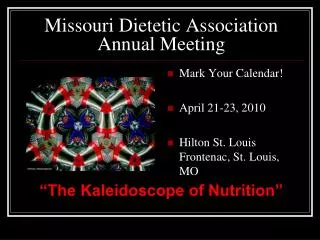
Missouri Dietetic Association Annual Meeting
Missouri Dietetic Association Annual Meeting Mark Your Calendar! April 21-23, 2010 Hilton St. Louis Frontenac, St. Louis, MO “The Kaleidoscope of Nutrition” 2010 Annual Meeting Planning Committee Members Veronica McDonnell, Chairperson Marsha Flowers Josh Dale
953 views • 14 slides
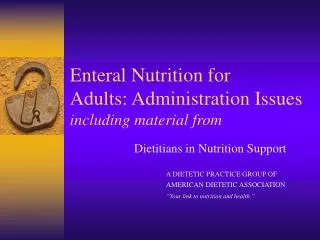
Enteral Nutrition for Adults: Administration Issues including material from
Enteral Nutrition for Adults: Administration Issues including material from. Dietitians in Nutrition Support A DIETETIC PRACTICE GROUP OF AMERICAN DIETETIC ASSOCIATION “Your link to nutrition and health.”. Contraindications for EN. Severe acute pancreatitis High output proximal fistula
2.12k views • 77 slides
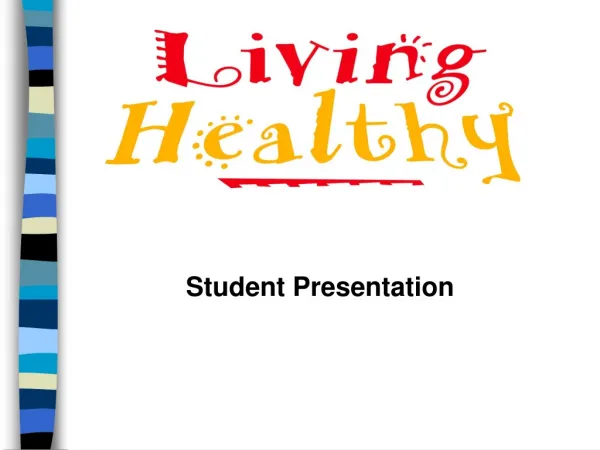
Student Presentation
Student Presentation. Let’s Talk. What are your favorite foods?. Helps you learn Promotes healthy weight Sports performance Keeps you healthy Prevents diseases Dental health. Sleep better Increase self-esteem & self-confidence Decrease depression & anxiety.
416 views • 20 slides
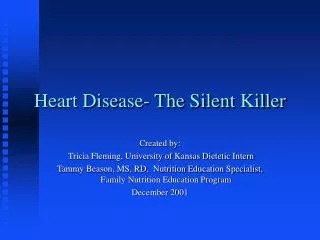
Heart Disease- The Silent Killer
Heart Disease- The Silent Killer. Created by: Tricia Fleming, University of Kansas Dietetic Intern Tammy Beason, MS, RD, Nutrition Education Specialist, Family Nutrition Education Program December 2001. What is Heart Disease?.
730 views • 41 slides
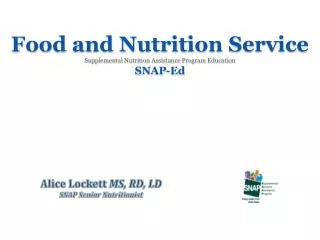
Food and Nutrition Service Supplemental Nutrition Assistance Program Education SNAP-Ed
Food and Nutrition Service Supplemental Nutrition Assistance Program Education SNAP-Ed. Alice Lockett MS, RD, LD SNAP Senior Nutritionist. SNAP-Ed Facts Figures. & . 2010 National Picture Submissions and Approvals. N = 52.
847 views • 49 slides

1 Supplemental Nutrition Assistance Program Strategies and Information for Maximizing Participation Presenter: Melissa
1 Supplemental Nutrition Assistance Program Strategies and Information for Maximizing Participation Presenter: Melissa Cundari Food and Nutrition Service United States Department of Agriculture. Purpose. Better understanding of SNAP policy Household Composition Non Citizens
271 views • 12 slides

Integration of a Nutrition Blog into a Hospital’s Employee Wellness Program
Integration of a Nutrition Blog into a Hospital’s Employee Wellness Program. Rebecca Scofield, MS Underwood-Memorial Hospital ARAMARK Dietetic Internship May 15, 2012. Introduction. Obesity-Related Costs Exceed $110 billion annually 1
372 views • 22 slides

Supplemental Nutrition Assistance Program Education and Evaluation Study (Wave II)
Supplemental Nutrition Assistance Program Education and Evaluation Study (Wave II). Anita Singh, PhD USDA, Food and Nutrition Service Office of Policy Support SNAP Research and Analysis Division ASNNA Winter Conference February 12, 2014.
303 views • 14 slides

HLT31507 CERTIFICATE III IN NUTRITION & DIETETIC ASSISTANCE
HLT31507 CERTIFICATE III IN NUTRITION & DIETETIC ASSISTANCE. THE CARDIOVASCULAR SYSTEM delivered by: Mary-Louise Dieckmann. A closed system of the heart and blood vessels The heart pumps blood Blood vessels allow blood to circulate to all parts of the body
349 views • 28 slides
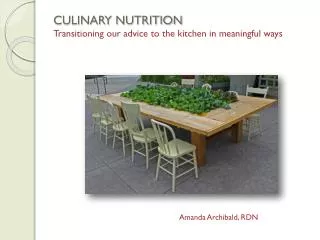
CULINARY NUTRITION Transitioning our advice to the kitchen in meaningful ways
CULINARY NUTRITION Transitioning our advice to the kitchen in meaningful ways. Amanda Archibald, RDN. Food for Thought. The kitchen is the root of the dietetic profession It is where we came from and where we must head back to OR deeply re-align ourselves
379 views • 25 slides

“Plating up a Healthier You” National Nutrition Month with Morrison Management Specialists
“Plating up a Healthier You” National Nutrition Month with Morrison Management Specialists Courtney Brooks, Dietetic Intern. Overview Learning to build a well balanced meal for general health using “ Plate Method ” Be able to take information to make healthy choices in the cafeteria
424 views • 17 slides
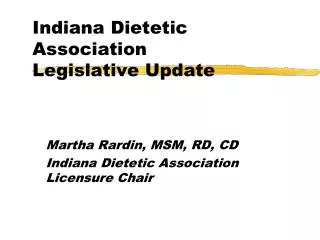
Indiana Dietetic Association Legislative Update
Indiana Dietetic Association Legislative Update. Martha Rardin, MSM, RD, CD Indiana Dietetic Association Licensure Chair. Future of Healthcare Professions is determined by the Congress of the US, not Associations, your education, or your professional career. Private Ins-33% Medicare-24%
513 views • 33 slides

HLT31507 CERTIFICATE III IN NUTRITION & DIETETIC ASSISTANCE
HLT31507 CERTIFICATE III IN NUTRITION & DIETETIC ASSISTANCE. CELLS & TISSUES delivered by: Mary-Louise Dieckmann. Cells are the building blocks of life They are comprised of four elements: Carbon Oxygen Hydrogen Nitrogen. Cells. Cells have three main parts: The plasma membrane
731 views • 61 slides
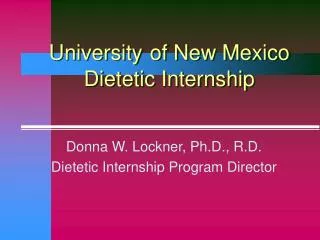
University of New Mexico Dietetic Internship
University of New Mexico Dietetic Internship. Donna W. Lockner, Ph.D., R.D. Dietetic Internship Program Director. Route to R.D. Bachelor’s Degree from CADE accredited program Complete CADE accredited Dietetic Internship Pass national R.D. exam. All CADE Accredited Internships Provide :.
328 views • 17 slides
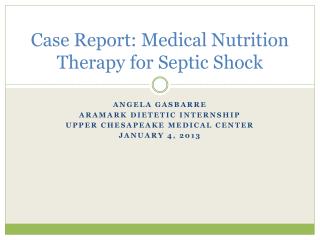
Case Report: Medical Nutrition Therapy for Septic Shock
Case Report: Medical Nutrition Therapy for Septic Shock. ANGELA GASBARRE ARAMARK DIETETIC INTERNSHIP UPPER CHESAPEAKE MEDICAL CENTER JANUARY 4, 2013. Objectives. Disease Description. Evidence-Based Nutrition Recommendations Early vs. Late Initiation of PN.
1.12k views • 15 slides
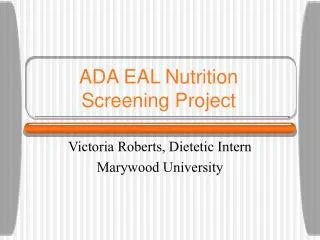
ADA EAL Nutrition Screening Project
ADA EAL Nutrition Screening Project. Victoria Roberts, Dietetic Intern Marywood University. Overview. What is the project? Selected topics Serum albumin Serum prealbumin MST tool MNA-SF tool NSMC nutrition screening. Nutrition Screening Evidence Analysis Project.
523 views • 28 slides

Food and Nutrition Service Supplemental Nutrition Assistance Program Education SNAP-Ed
Food and Nutrition Service Supplemental Nutrition Assistance Program Education SNAP-Ed. Alice Lockett MS, RD, LD SNAP Senior Nutritionist. SNAP-Ed Facts Figures. &. 2010 National Picture Submissions and Approvals. N = 52.
724 views • 49 slides

Iowa’s supplemental nutrition assistance program
Iowa’s supplemental nutrition assistance program. Program’s Purpose. Provide nutrition to those who simply cannot afford to get the nutrition themselves. Electronic Benefit Transfer Card Income and assets requirements. Blogspot.com. Benefits. Mentally and physically d isabled Unemployed
266 views • 10 slides
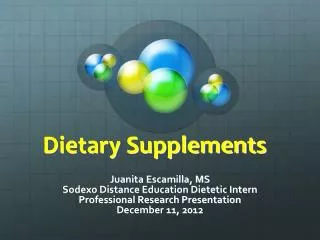
Dietary Supplements
Dietary Supplements . Juanita Escamilla, MS Sodexo Distance Education Dietetic Intern Professional Research Presentation December 11, 2012. Background and Research. BS, Food and Nutrition and MS Human Nutrition (Food Biotechnology and Molecular Nutrition)
702 views • 35 slides

JOURNAL OF THE AMERICAN DIETETIC ASSOCIATION
A Vegetarian Dietary Pattern as a Nutrient Dense Approach for Weight Management: An Analysis of the National Health and Nutrition Examination Survey (NHANES) 1999-2004. Bonnie Farmer, M.S., RD: PlantWise Nutrition Consulting, LLC Brian T Larson, PhD: JG Consulting Services, LLC,
318 views • 15 slides
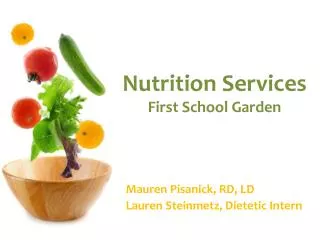
Nutrition Services First School Garden
Nutrition Services First School Garden. Mauren Pisanick, RD, LD Lauren Steinmetz, Dietetic Intern. Idea for a school garden…. To earn a badge for the Eagle Scouts, Hayden Smart, a HHS 2011 Graduate, designed an arrangement of vegetables and herbs for a plot of land excavated for the garden.
301 views • 13 slides























